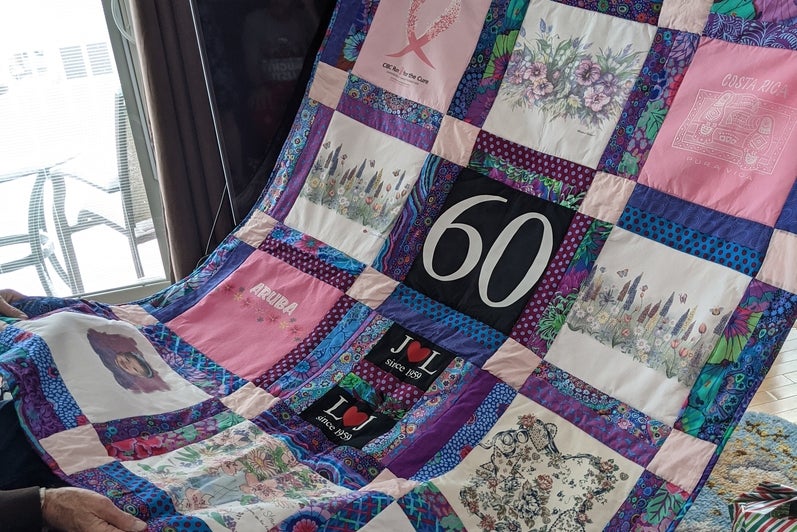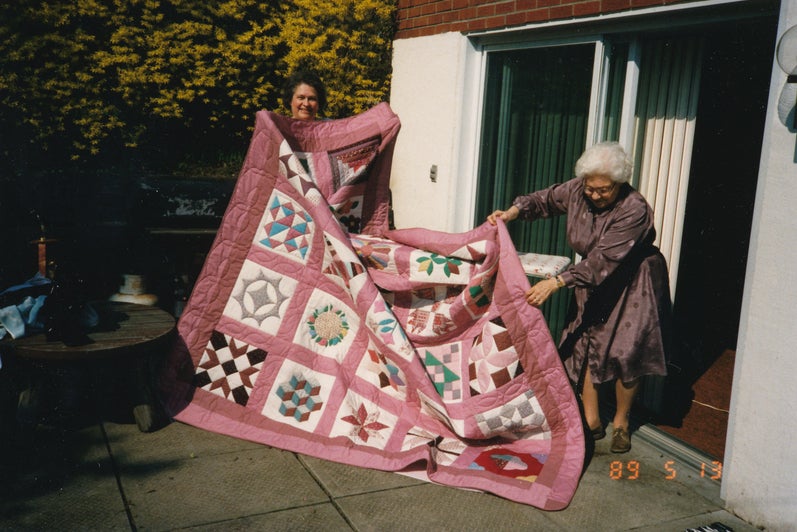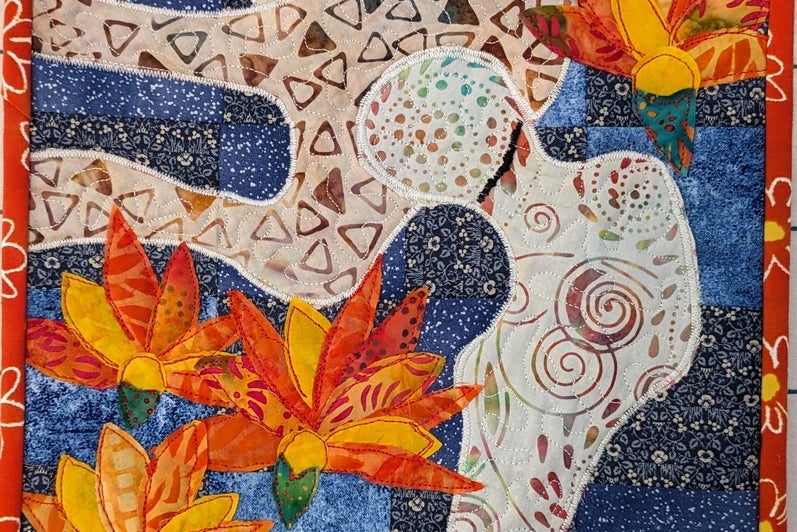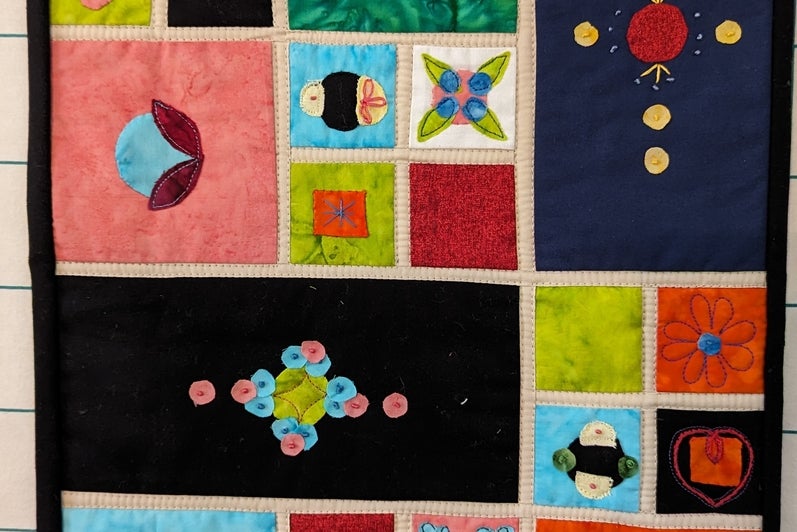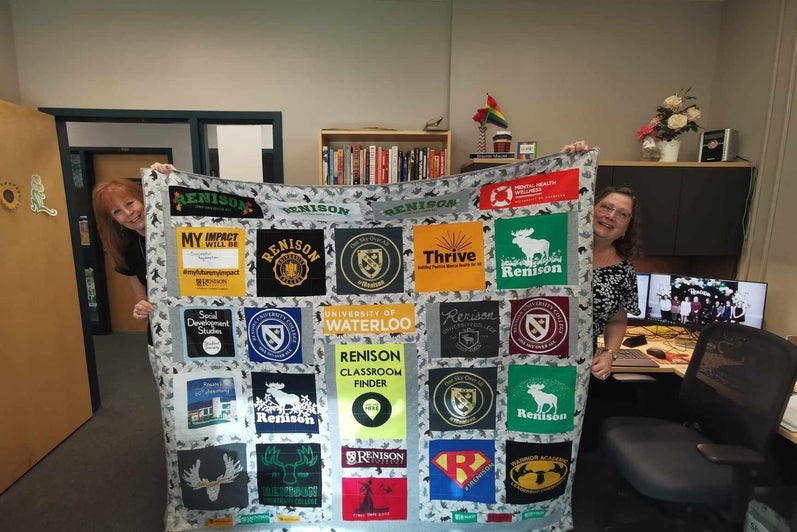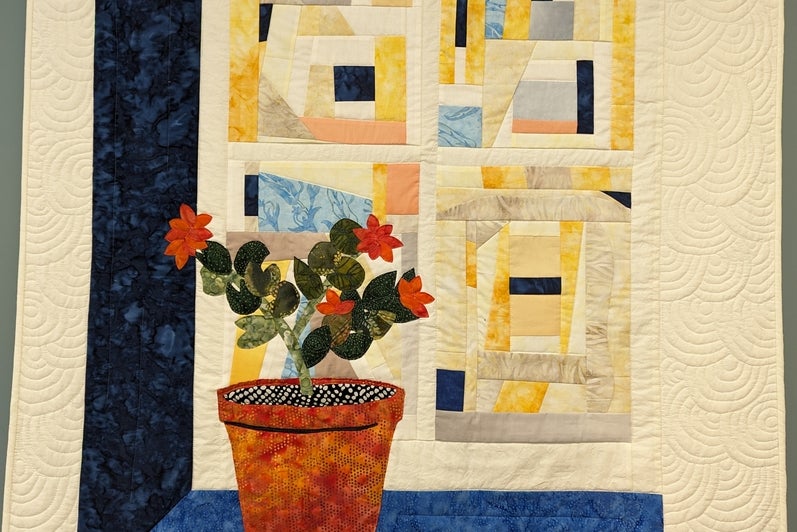
Brenda Maciel works on a quilt at her kitchen island.
Quilting is a handicraft with a long history. Some sources suggest it emerged during Medieval times as a quilted garment under armor, but there is evidence that stitching padding and fabric together could date back as far as 3400 BCE! Since the beginnings, quilted items have been practical and beautiful, and provided a focal point for social interaction. Ever heard of a quilting bee? It’s a gathering where quilters share skills and techniques, and generally catch up.
It’s no wonder why this craft has such longevity. Two members of the Renison community, Brenda Maciel and Julia Williams, have picked up the needle and found peace (or perhaps piece) in patchwork.
For Brenda Maciel, Assistant to the School of Social Work, the call to quilting came during the COVID-19 pandemic. Brenda has a strong creative side; her cricut creations are legendary around Renison, and can be seen hanging through the Social Work hallway and various places on campus. Quilting was another hobby to spend time on amidst bouts of crafting, cross-stitch and sewing, and she pursued it with vigor.
The idea for Brenda’s first quilt took hold during another project, sewing pyjamas for her child’s first term in university residence. She came across a t-shirt quilt and thought, “I want to try that” and so she did! The first quilt was sewn for her Dad after her Mother’s passing and the project was, in her own words, “terrifying.” After that, Brenda developed her skills by making baby quilts with pre-cut fabric, and started visiting the quilting stores in the area. She was off and running – or more accurately driving - to quilting stores near and far for expertise.
It’s probably no surprise, but Brenda has quilting in her genes. Her grandmother and great aunt were the quilters in the family; Brenda has three quilts from her great aunt, including a quilt given as a wedding present. More recently, Brenda found a photo of her mother and grandmother holding a quilt she’d never seen before. Each block is a different pattern, and she hopes to recreate it in honour of the family quilters. It hasn’t been an easy process, however, it’s taken time and consultation with her favourite quilt store owner to identify each pattern.
Julia Williams, Chair and Professor in Renison’s Culture and Language Studies department, is also an avid quilter. She began quilting as an adult but always liked to create and really enjoyed sewing ever since learning to sew in a school home economics course. From there she practiced on an old Singer sewing machine she received as a gift from her mother when she was just a teenager.
For Julia, too, there was a moment in time when it became obvious that quilting was a good fit for her. She started by taking a quilting course with a friend, creating several quilted blocks and learning techniques and skills before putting everything together. She says that her sewing experience worked in her favour; the stitching came naturally.
Julia favours art quilts, which don’t follow a set pattern, but she switches back and forth between creating the large quilts that can be used for beds, and art quilts, which are typically used as wall hangings. According to Julia, art quilts are particularly challenging because of the lack of pattern “you just have to figure out what you want to create.” That said, she loves a great pattern and beautiful fabrics and seeing how things come together with a great combination.
The history of quilting and fabrics is a source of inspiration for Julia. She shares that quilts have been used as maps and directional signs based on the design – and they were even used to show the way for those following the underground railway!
Currently, Julia is working on a quilt made up of fabric from her grandparents’ house, which date in and around the 1920s. The fabrics of the time were very different from what is available and fashionable now, and they are also very delicate due to their age. She has learned a lot about fabrics from her travels around the world and has fabrics from Africa, the Middle East and the Netherlands.
Looking at fabrics in new places is one of the things Julia recommends for new quilters – to explore and look around at quilting stores, “you can learn a lot from just looking around!”
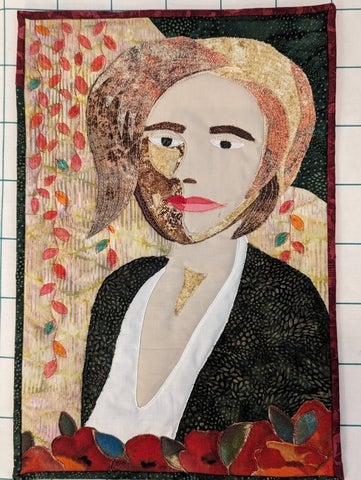
A self-portrait art quilt created by Julia.
Both Brenda and Julia have great advice for anyone thinking about taking up quilting:
Brenda: Start small; pre-cut fabric might be more expensive but, especially for small projects, it makes learning easy and you’ll make fewer mistakes. You can
learn a lot from Youtube and find free patterns online. I also recommend waiting to spend a lot of money on a sewing machine until you really know you want to stick with quilting. And finally – shop local and ask questions!
Julia: Go ahead and try it – it’s so much fun! Start small, you’ll get a lot of satisfaction from creating something yourself. An introductory course is a great way to get started because you’ll learn the basics and be able to ask questions.
This is part of the 2024 Renison Reports publication. Return to the Renison Reports page for other articles.
